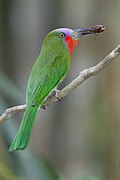|
Nyctyornis
Nyctyornis is a genus of the bee-eaters, near passerine birds in the family Meropidae. There are just two members of this group, which occur in tropical south and southeastern Asia.[2]
The genus Nyctyornis was introduced by the naturalists William Jardine and Prideaux John Selby in 1830.[3][4] The name comes from the Ancient Greek nukt meaning nocturnal or night and ornis meaning bird.[5] A molecular phylogenetic study published in 2007 showed that the genus is basal and forms a sister group to the remaining members of the bee-eater family.[6] Like other bee-eaters, Nyctyornis species are colourful birds with long tails, long downturned bills and pointed wings. They are large bee-eaters (blue-bearded is the largest of all bee-eaters),[7] predominantly green, with a face colour as indicated by the species' name. This colour extends on to the slightly hanging throat feathers to form the "beard".[8] The two Nyctyornis species are the only bee-eaters that lack an eye-stripe and that have bi-coloured beaks.[6] Their calls also differ from those of other bee-eaters and are somewhat similar to the noises made by rollers.[9] Their size and more rounded wings give a heavier flapping flight that is less graceful than that of members of the genus Merops.[9] In common with other bee-eaters, they predominantly eat insects, especially bees, wasps and hornets, which are caught in the air, but they have a rather different strategy. They hunt alone or in pairs, rather than in groups, and sit motionless for long periods before pursuing their prey.[9] The blue-bearded bee-eater will also clamber in foliage for insects, and bees are sometimes attracted by the bright blue beard of a perched bird, presumably mistaking it for a flower.[10] They nest in burrows tunneled into the side of sandy banks, but do not form colonies.[11] References
Sources
|
||||||||||||||||||||||||||||||||||||||||||










